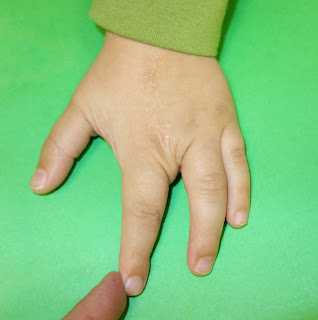When surgery is required for cleft hand, the goal is to create a maximally functional hand that is as “normal” appearing as possible. While each child with cleft hand is different, usually we can create a hand that works well and looks good. However, certain challenges exist after surgery related to hand anatomy. A cleft hand is not only missing bone, it is also missing muscle (called intrinsic muscle), tendon, and the ligaments may be weak as well. We believe that there are 3 primary functional limitations after reconstruction for cleft hand (these same limitations are likely present without surgery).
#1 The space between the thumb and index finger is called the first web space. It is vital for grabbing large objects and for hand use overall. We all tend to use this space to hold objects like soda cans. If the space is small, it becomes impossible to hold such objects with then hand. The other hand or both hands are then required. Cleft hand almost always has a small web space between the index and long fingers. Therefore, part of surgery is to reconstruct this space. I have written about this issue already.
http://congenitalhand.wustl.edu/2013/05/cleft-hand-long-term-follow-up.html and
http://congenitalhand.wustl.edu/2012/05/cleft-hand-surgery.html
#2 The ring finger may be affected with cleft hand as it can be difficult to straighten the finger fully. The intrinsic muscles (those muscles in the palm that normally help to straighten the fingers) may be absent next to the cleft and, therefore, the ring finger may not get the normal muscle that it should. Without this intrinsic muscle, straightening the finger may be a challenge at the PIP joint (first knuckle in finger). There is no easy solution to this problem but fortunately, most kids function just fine even if the finger does not straighten fully.
 |
| Right cleft hand. Not that the ring finger does not straighten fully. The thumb- index web space has been reconstructed as has the ring- small finger space. |
 |
| Palmar view of cleft hand after reconstruction. |
 |
| Fist in cleft hand after reconstruction. Function is excellent. |
#3 The final function issue in cleft hand is the stability of the knuckles. The MCP joint connects the fingers to the hand. Normally, this joint allows you to bend and straighten the fingers but not a great deal of side to side motion. If the ligaments that normally stabilize the MCP joint are not strong in cleft hand, the joints may move too much- so- called joint laxity. This laxity or instability is most common in the index and ring fingers. Often it does not cause a functional problem but sometimes it will and we use surgery to stabilize the joint. This can be tricky because we also need to protect the normal structures including the growth plates. Here is an example of a patient after cleft hand reconstruction. He is doing great, family is very happy and they do not want additional surgery now. However, we spent some time discussing the index finger. He might benefit from re- aligning the index finger (i.e., cutting and straightening the metacarpal bone) and stabilizing the joint. The thumb, ring, and small finger look great. The thumb- index web space also looks great. The finger alignment is the primary issue.
 |
| Cleft hand– left side- after reconstruction. Gentle stress provides good alignment. |
 |
| Left cleft hand after reconstruction. Note deviated index finger but rest of hand looks great. |
 |
| Palmar view of cleft hand after reconstruction. |





